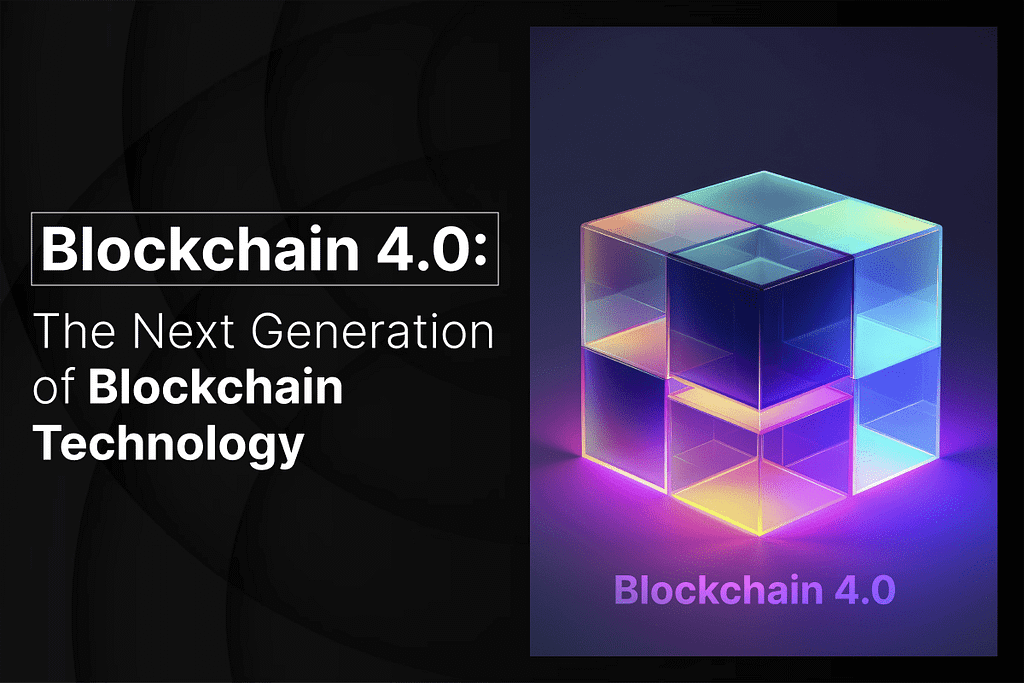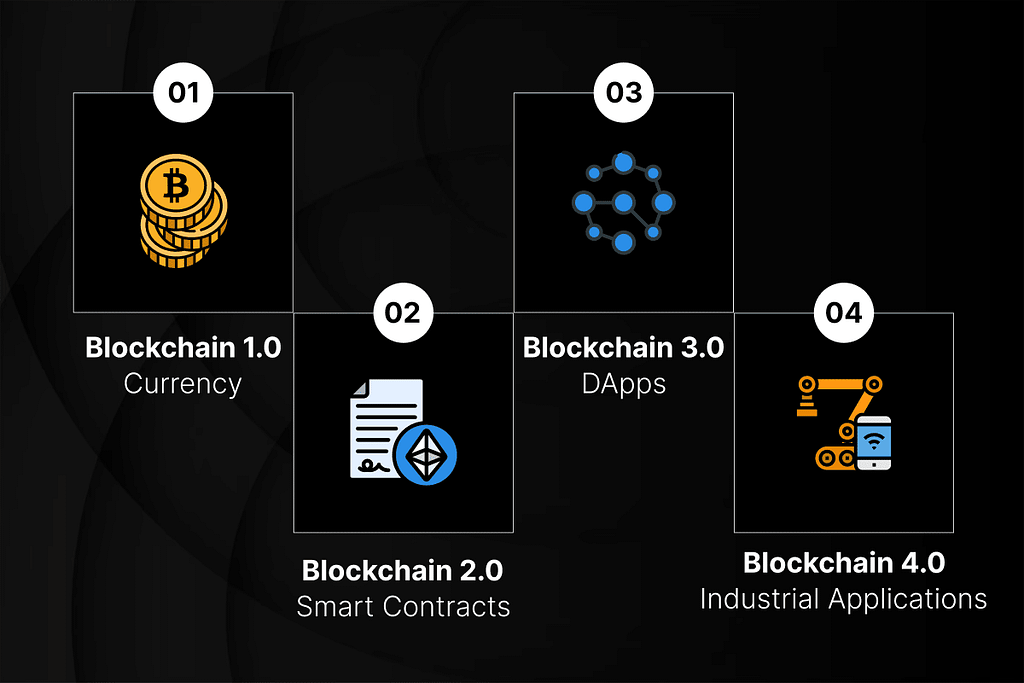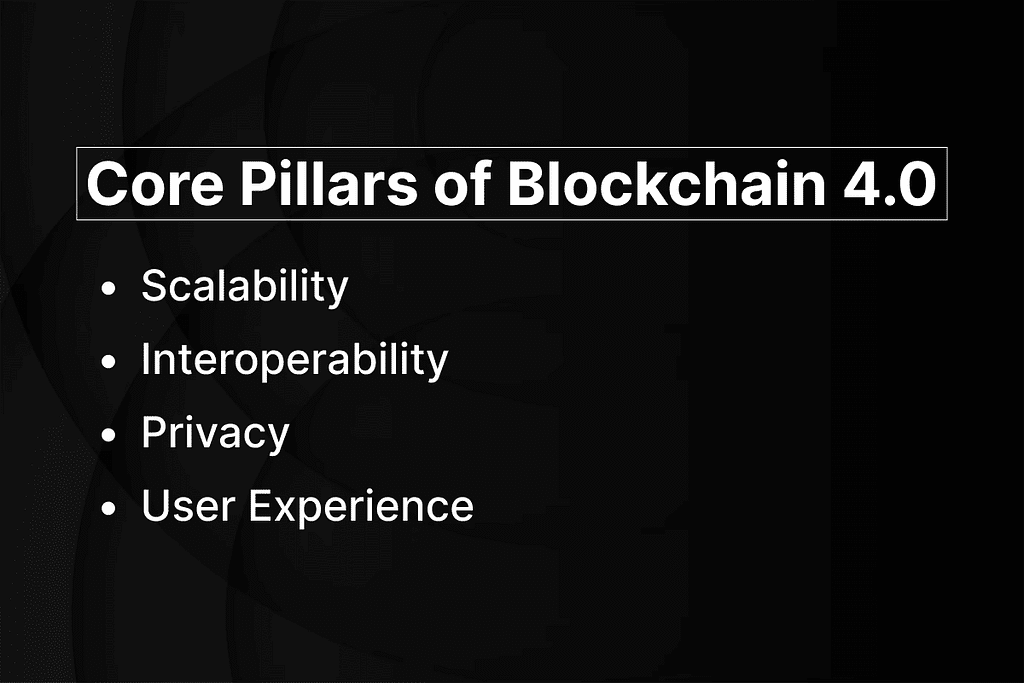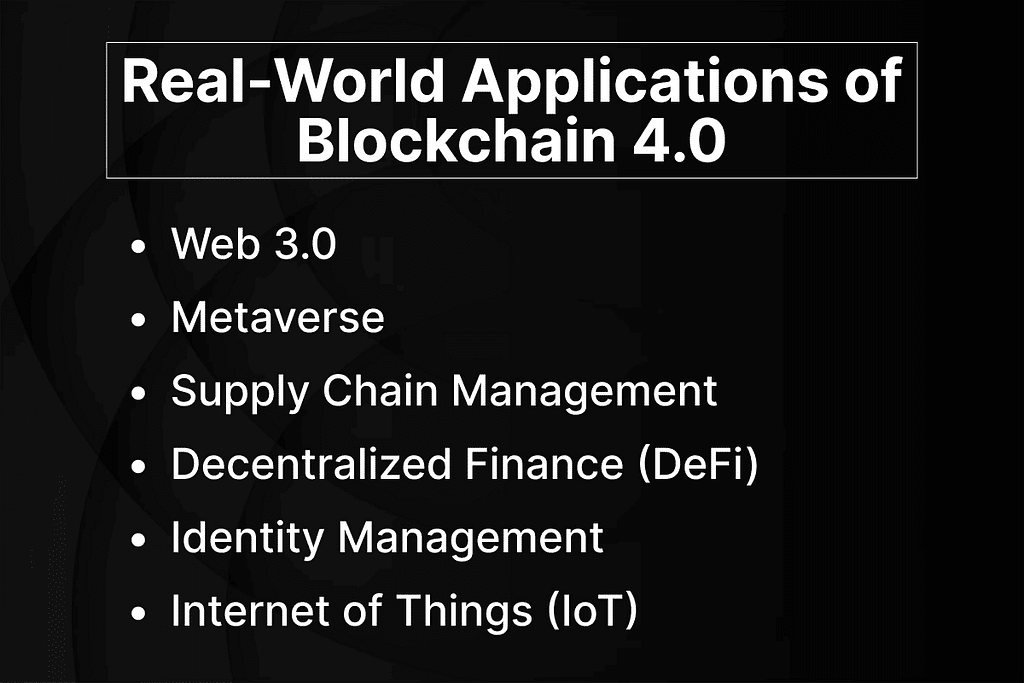
Blockchain technology has come a long way, advancing rapidly since its inception. Each generation brought about notable advancements and addressed specific limitations. Blockchain 1.0 primarily focused on cryptocurrencies, establishing a decentralized platform for peer-to-peer transactions. Blockchain 2.0 expanded this concept by incorporating smart contracts, facilitating automated agreements and reducing transaction costs. The introduction of Blockchain 3.0 further advanced the technology with decentralized applications (DApps), improving user experience and promoting greater scalability and flexibility.
Building upon these foundations, Blockchain 4.0 comes up as the next evolutionary step. This next generation is defined by its core principles of scalability, interoperability, enhanced privacy, and improved user experience. By addressing the limitations of its predecessors, Blockchain 4.0 aims to create a more efficient and user-friendly environment for both developers and end-users.

One of the most significant challenges that Blockchain 4.0 addresses is the issue of scalability, which has obstructed the widespread adoption of blockchain solutions. Additionally, it focuses on interoperability, allowing different blockchain networks to communicate effectively. Improved privacy measures and a more intuitive user experience are also key components that will facilitate broader acceptance across various industries.
Understanding the Evolution of Blockchain
To fully appreciate the significance of Blockchain 4.0, it is essential to examine the progression of blockchain technology from its early stages to the present day. Blockchain 1.0, exemplified by Bitcoin, revolutionized the financial sector by introducing a decentralized digital currency system. However, its primary focus on cryptocurrency limited its broader applications and adoption.
Blockchain 1.0 (Cryptocurrency)
Blockchain 1.0 is based on a peer-to-peer network where nodes validate transactions and add them to the blockchain. The consensus mechanism used in Blockchain 1.0 is Proof of Work (PoW), where miners compete to solve complex mathematical problems to validate transactions and add new blocks to the chain. This process ensures the integrity of the blockchain by making it computationally expensive to modify past transactions.
One of the key limitations of Blockchain 1.0 is its scalability and transaction speed. Bitcoin, the first example of Blockchain 1.0, can only process around 7 transactions per second, which is considerably lower than traditional payment systems. This limitation is due to the block size and block time constraints in the Bitcoin protocol. Additionally, as the network grows, the computational power required for mining increases, leading to higher energy consumption and slower transaction confirmation times.
Another limitation of Blockchain 1.0 is its vulnerability to 51% attacks, where a group of miners controlling more than 50% of the network’s computational power can potentially manipulate the blockchain. This vulnerability is inherent in the PoW consensus mechanism, as it relies on the assumption that no single entity can control a majority of the network’s computing power.
Blockchain 2.0 (Smart Contracts)
Blockchain 2.0, represented by Ethereum, marked a crucial turning point with the introduction of smart contracts. Smart contracts are self-executing programs that automate the actions required in a blockchain transaction, allowing for more complex interactions beyond simple currency transfers. They operate on a decentralized network, allowing for agreements to be executed automatically when predefined conditions are met.
The architecture of Blockchain 2.0 allows developers to create decentralized applications (DApps) that can run on the Ethereum Virtual Machine (EVM). This flexibility facilitates a wide range of applications, from financial services to supply chain management, all of which can benefit from the automation and transparency provided by smart contracts. The use of smart contracts reduces the need for intermediaries, thereby lowering costs and increasing efficiency.
However, Blockchain 2.0 also faced challenges, particularly concerning scalability. Ethereum’s PoW consensus mechanism limited transaction throughput, often resulting in network congestion during peak usage times. Furthermore, the immutability of smart contracts means that any coding errors can lead to irreversible consequences, highlighting the importance of rigorous testing and auditing.
Blockchain 3.0 (Decentralized Applications or DApps)
Blockchain 3.0 further expanded the capabilities of blockchain by facilitating the creation of DApps across various industries, such as healthcare, education, and government. This phase focused on the capability of blockchain to solve real-world problems and drive innovation. DApps tap into the underlying blockchain’s features — such as transparency, security, and decentralization — to provide services that are resistant to censorship and fraud.
DApps can operate on various blockchain platforms, not just Ethereum, allowing for greater diversity in application development. They utilize a range of consensus mechanisms, including Proof of Stake (PoS) and Delegated Proof of Stake (DPoS), which aim to improve scalability and reduce energy consumption compared to PoW.
Despite these advancements, the adoption of blockchain technology remained limited due to ongoing issues related to scalability, interoperability, and user-friendliness. Many DApps struggled with user experience, often requiring technical knowledge that deterred mainstream users.
Transition to Blockchain 4.0 — Real-World Utility and Mass Adoption
The transition to Blockchain 4.0 represents a crucial shift in focus, moving beyond the limitations of its predecessors. This next generation of blockchain aims to address the pressing need for real-world utility and mass adoption by prioritizing scalability, interoperability, privacy, and user experience.
Blockchain 4.0 seeks to integrate advanced technologies such as artificial intelligence (AI), metaverse, and the Internet of Things (IoT) to create systems that can operate autonomously and efficiently. By tapping into these technologies, Blockchain 4.0 aims to facilitate effective interactions between various blockchain networks and traditional systems, leading to broader adoption across industries.
In essence, Blockchain 4.0 is set to revolutionize various sectors by effectively tackling the challenges that have hindered its growth. This evolution reflects a commitment to creating a more interconnected and efficient ecosystem, where blockchain can serve as a foundational technology for future innovations.
Core Pillars of Blockchain 4.0

Blockchain 4.0 is characterized by a focus on several key pillars that address the limitations of previous generations. Scalability, interoperability, privacy, user experience, and the integration of artificial intelligence and machine learning are crucial elements that define this new era of blockchain technology.
Scalability
Scalability has been a persistent challenge for blockchain technology, particularly in its earlier iterations. Blockchain 1.0 primarily focused on cryptocurrency transactions, with Bitcoin capable of processing only about 7 transactions per second (TPS). This limitation became increasingly evident as user adoption grew, leading to network congestion and high transaction fees. Blockchain 2.0, while introducing smart contracts and decentralized applications (DApps), still struggled with scalability, as Ethereum could handle around 20 TPS, far below the capabilities of traditional payment systems like Visa, which can process over 1,700 TPS.
To address these challenges, several innovative solutions have been introduced in Blockchain 4.0.
- Sharding: This technique involves partitioning the blockchain into smaller, more manageable pieces called shards, each capable of processing its transactions and smart contracts. This parallel processing considerably increases the overall throughput of the network.
- Layer-2 Solutions: These are secondary frameworks built on top of existing blockchains to boost scalability. Examples include the Lightning Network for Bitcoin and Optimistic Rollups for Ethereum, which allow transactions to be processed off-chain and then settled on the main chain, reducing congestion.
- Consensus Mechanisms: New consensus algorithms, such as Proof of Stake (PoS) and Delegated Proof of Stake (DPoS), are being adopted to improve transaction speeds and energy efficiency. These mechanisms require less computational power than traditional Proof of Work (PoW) systems, allowing for faster transaction confirmations.
Moreover, interoperability plays a crucial role in scaling blockchain networks. By allowing different blockchains to communicate and share data, interoperability can alleviate congestion on individual networks. Projects like Polkadot and Cosmos are pioneering this approach, allowing multiple chains to operate cohesively, thus improving overall scalability.
Interoperability
Interoperability is vital for the future of blockchain technology, as it facilitates cross-chain communication and data exchange. In a multi-blockchain ecosystem, the ability for different networks to interact effectively is critical for maximizing the utility of blockchain applications.
- Importance of Cross-Chain Communication: Cross-chain interoperability allows users to transfer assets and data between different blockchain networks without relying on centralized exchanges. This capability improves liquidity and broadens the range of services available to users, leading to a more integrated blockchain ecosystem.
- Technical Aspects of Interoperability Protocols: Various protocols are being developed to facilitate interoperability, such as Atomic Swaps, which allow for peer-to-peer trading of cryptocurrencies across different blockchains, and the Inter-Blockchain Communication (IBC) protocol, which facilitates communication between different chains in the Cosmos ecosystem.
- Real-World Use Cases: Interoperable blockchains can significantly benefit industries such as finance, supply chain, and healthcare. For instance, in finance, users could move assets between DeFi platforms on different blockchains, enhancing investment opportunities. In supply chain management, data from various blockchains could be aggregated to provide a holistic view of product provenance and logistics.
Privacy
Privacy remains a critical concern for any blockchain development company. This is particularly true for public blockchains where transaction details are visible to all participants. This transparency can pose risks for sensitive information.
- Privacy Concerns in Public Blockchains: Users may be hesitant to engage in transactions on public blockchains due to the potential exposure of their financial and personal data. This concern can obstruct widespread adoption, particularly in industries that handle sensitive information.
- Zero-Knowledge Proofs and Homomorphic Encryption: Advanced cryptographic techniques such as zero-knowledge proofs (ZKPs) allow one party to prove to another that a statement is true without revealing any specific information about the statement itself. Homomorphic encryption allows computations to be performed on encrypted data without decrypting it, offering data privacy during processing.
- Privacy-Preserving Smart Contracts: These smart contracts utilize cryptographic techniques to keep transaction details confidential while still being verifiable. Applications include confidential transactions in finance and secure voting systems, where the privacy of voters is essential.
User Experience
User experience is a significant barrier to the adoption of blockchain technology. Many existing applications require technical knowledge that can alienate potential users.
- Challenges in User Adoption: The complexity of blockchain technology often leads to a steep learning curve for new users. Complicated wallet setups, transaction processes, and security measures can deter individuals from engaging with blockchain applications.
- Importance of Intuitive Interfaces: To boost user adoption, blockchain applications must prioritize user-friendly interfaces that simplify interactions. This includes clear navigation, easy onboarding processes, and accessible educational resources.
- User Experience Design Principles: Effective user experience design for blockchain applications involves principles such as simplicity, consistency, and feedback. Ensuring that users can easily understand and navigate the application will lead to greater trust and engagement.
Artificial Intelligence and Machine Learning
The integration of artificial intelligence (AI) and machine learning (ML) into blockchain technology presents exciting opportunities for optimization and efficiency.
- Integration of AI and ML for Blockchain Optimization: AI and ML can analyze blockchain data to identify patterns and optimize processes. For example, predictive analytics can forecast transaction trends and user behavior, allowing for better resource allocation and network management.
- Use Cases: Applications of AI and ML in blockchain include fraud detection, where algorithms can analyze transaction patterns to identify suspicious activities, and smart contracts that adapt based on real-time data inputs, enhancing their functionality and responsiveness.
- Impact on Blockchain Efficiency and Decision-Making: The combination of AI and blockchain can lead to improved decision-making processes by providing actionable insights derived from data analysis. This synergy can improve the efficiency of operations across various sectors, including finance, logistics, and healthcare, driving greater adoption of blockchain technology.
Real-World Applications of Blockchain 4.0

Blockchain 4.0 is moving from theory to practice, with a growing number of real-world applications. Let’s explore some key areas where it’s making a difference.
Web 3.0
Web 3.0 represents the evolution of the internet, emphasizing decentralization and user control over data. Blockchain technology plays a crucial role in this transformation by facilitating peer-to-peer interactions without intermediaries. In Web 3.0, users can own their data and engage in transactions directly, creating a more equitable ecosystem.
- Decentralized Applications (DApps): Web 3.0 applications utilize blockchain to create decentralized platforms where users can interact directly. This reduces reliance on centralized entities and improves privacy and security. Examples include decentralized social networks and content-sharing platforms that reward users for their contributions.
- Tokenization: Blockchain allows for the tokenization of assets, facilitating fractional ownership and easier transfer of value. This approach can democratize access to investments, allowing more individuals to participate in markets that were previously inaccessible.
Metaverse
The metaverse is a virtual environment where users can interact in real-time, blending physical and digital experiences. Blockchain technology is integral to the metaverse, providing the infrastructure for ownership and transactions within these virtual spaces.
- Digital Ownership: Blockchain allows users to own virtual assets, such as land, avatars, and digital collectibles, through non-fungible tokens (NFTs). This ownership is verifiable and secure, letting users trade or sell their assets freely.
- Interoperability: The metaverse benefits from interoperability between different virtual worlds. Blockchain facilitates this by allowing assets and identities to move across various platforms, enhancing user experience and engagement.
Supply Chain Management
Blockchain technology enhances supply chain management by improving transparency, traceability, and fraud prevention. It provides a decentralized ledger that records every transaction in the supply chain. This transparency allows all participants to verify the authenticity of products, reducing the risk of fraud. For instance, in the food industry, blockchain can trace the journey of food items from farm to table, ensuring quality and safety.
The combination of blockchain with Internet of Things (IoT) devices allows for real-time data integration. Sensors can track conditions such as temperature and humidity during transportation, automatically updating the blockchain with this information. This integration helps maintain product integrity and optimize logistics.
Case Studies: Companies like Walmart and IBM have successfully implemented blockchain solutions in their supply chains. Walmart uses blockchain to track the origin of food products, allowing for faster responses to food safety issues. IBM’s Food Trust network connects various stakeholders, improving transparency and collaboration.
Decentralized Finance (DeFi)
Apart from traditional lending and borrowing, DeFi includes a wide range of financial services. For instance, it comprises derivatives, insurance, and asset management, allowing users to engage in complex financial transactions without intermediaries. This democratization of finance provides access to a broader audience and reduces costs.
To support the growing DeFi ecosystem, various scalability solutions are being developed. Layer-2 scaling solutions, such as Optimistic Rollups, help increase transaction throughput while maintaining security. Interoperability protocols allow different DeFi platforms to communicate, improving user experience and expanding service offerings.
As DeFi continues to grow, regulatory challenges arise. Compliance with existing financial regulations is crucial to ensure user protection and prevent illicit activities. Ongoing discussions among regulators and industry participants aim to establish frameworks that balance innovation with security.
Identity Management
Blockchain technology is transforming identity management by promoting decentralized identity systems and data ownership.
- Decentralized Identity: Users can control their personal information through decentralized identity solutions, reducing reliance on centralized authorities. This approach enhances privacy and security, as users can selectively share their data with trusted parties.
- Self-Sovereign Identity: This concept allows individuals to manage their identities without third-party intervention. Users can verify their identity using blockchain-based credentials, simplifying processes such as onboarding and verification in various sectors.
- Use Cases: In government, blockchain can streamline identity verification processes for services such as voting and public benefits. In healthcare, patients can manage their medical records securely and share them with providers as needed. In finance, blockchain-based identity solutions can facilitate customer onboarding while ensuring compliance with Know Your Customer (KYC) regulations.
Internet of Things (IoT)
Blockchain technology adds to the security and management of data generated by IoT devices. By storing IoT data on a blockchain, organizations can attain data integrity and security. This decentralized approach reduces the risk of data tampering and unauthorized access.
Blockchain can facilitate secure authentication of IoT devices so that only authorized devices can connect to the network. Smart contracts can automate interactions between devices, enabling efficient communication and data exchange.
In smart cities, blockchain can be used to manage data from various sensors, optimizing resource allocation and improving urban planning. In industrial IoT, blockchain can track equipment performance and maintenance schedules, improving operational efficiency.
Challenges and Opportunities
As Blockchain 4.0 gains traction, it faces several challenges that must be addressed to promote widespread adoption and success. These challenges span technical, regulatory, economic, and social domains.
- Technical Challenges
One of the primary technical challenges in implementing Blockchain 4.0 is the complexity of integrating various components, such as scalability solutions, interoperability protocols, and privacy-enhancing technologies. Facilitating effective communication and compatibility between these systems is crucial for creating a cohesive and efficient blockchain ecosystem.
Another challenge lies in the development of user-friendly interfaces and tools that can simplify the interaction with blockchain applications. Overcoming the steep learning curve associated with blockchain technology is essential for attracting mainstream users and driving broader adoption.
- Regulatory Frameworks
The regulatory frameworks surrounding blockchain technology are constantly evolving, with different jurisdictions taking varied approaches. It requires close cooperation between industry players, regulators, and policymakers to set clear guidelines that support innovation while addressing concerns related to consumer protection, anti-money laundering, and financial stability.
Compliance with existing regulations, such as data privacy laws and financial reporting requirements, can present challenges for blockchain projects. Adapting to these regulations while maintaining the core principles of decentralization and transparency is a delicate balance that must be struck.
- Economic and Social Implications
The widespread adoption of Blockchain 4.0 can disrupt traditional business models and create new economic opportunities. Tokenomics services, the rise of decentralized finance, and the emergence of new revenue streams through blockchain-based applications can lead to a more inclusive and equitable financial system.
However, the transition to a blockchain-based economy also raises concerns about the potential impact on employment, as certain intermediary roles may become obsolete. Policymakers and industry leaders must work together to address these challenges and ensure that the benefits of blockchain technology are distributed fairly across society.
- Opportunities for Innovation and Research
Despite the challenges, Blockchain 4.0 presents numerous opportunities for innovation and research. With advancements in the technology, there is a growing need for skilled professionals who can design, develop, and implement blockchain solutions. Educational institutions and training programs are responding to this demand, creating new courses and programs focused on blockchain technology.
Moreover, ongoing research in areas such as consensus mechanisms, cryptography, and scalability solutions can lead to further advancements in blockchain technology. Collaborations between academia, industry, and government can promote innovation and drive the development of cutting-edge blockchain applications.
The Final Takeaway
Blockchain 4.0 promises to address key challenges such as scalability, interoperability, and privacy. The integration of advanced technologies will further enhance the capabilities of blockchain, leading to innovative applications and improved efficiencies.
As research and development progress, we can anticipate advancements in scalability, interoperability, and privacy. These improvements will make blockchain technology more accessible and practical for a wider range of applications.
The future of blockchain is bright, but realizing its full potential requires collaboration between governments, businesses, and researchers.
Ready to harness blockchain for your business? Codezeros specializes in enterprise blockchain development and consulting services. Our team of experts can help you with anything blockchain — from strategy development to technical implementation.
Contact us today for a consultation to discuss your blockchain project.
Source — https://www.codezeros.com/blockchain-4.0-the-next-generation-of-blockchain-technology
Blockchain 4.0: The Next Generation of Blockchain Technology was originally published in Coinmonks on Medium, where people are continuing the conversation by highlighting and responding to this story.








